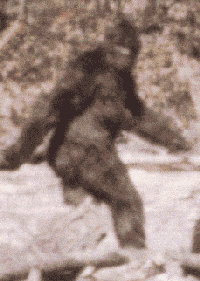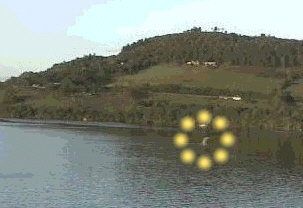|

If you know of any Interesting Myths then email me or go to the editor page.
Bigfoot and the Yeti
There are numerous sightings and accounts of the "Yeti." Here are some interesting statistics on the "Yeti."
The "Yeti," like the "Big Foot's" of the North American continent, has been in existence for 6,000 years. There are no rivalries amongst the "Yeti" population. They also divide their family's with other "Yeti" families, to prevent in-breeding and depletion of their species. However, the similiarity ends there. Unlike "Big Foot," the "Yeti" did not evolve from an animal species, they evolved from the "caveman." They can be found in China, the Himalayas and on up into the former Soviet Union to Siberia. They are not related to "Big Foot." The total "Yeti" population is around 227. Their average life span is between 120 and 130 years. They are "carnivorous."
They normally have 3 per family group and they live in caves. The number of family groups is unknown, at this time. The male is around 7 feet tall and the female, around 6 feet. The male's weight is between 300 and 350 pounds and the female is around 200 and 250 pounds. They forage for food during the daylight hours. The male does not live with the family, he is a "loner." He mates with a female, then leaves, and the female is left to raise the "off-springs.
Stories of the Yeti vary in detail but many of them suggest a creature with an apelike body and a human-like face. Nepalese Sherpas have described the Yeti as having long, reddish-brown hair all over its body. One Sherpa monastery exhibited a Yeti "portrait" resembling the crossing of a wolf, tiger, and bear. Folklore describes a fearsome, savage beast with a high-pitched whistling scream; a vile, pungent odor; feet that point backwards; and supernatural powers. Superstitions say that sighting the creature can bring ill fortune, illness, or death.

Another name for the Yeti is metoh-kangmi, a term mistakenly translated into English as "abominable snowman." That alluring name has stuck. The Yeti, which is supposed to live high in the Himalaya but has also been reported as far away as the European Alps, is said to prowl by night leaving huge footprints in the snow.
Many expeditions have attempted to prove the Yeti's existence, but no scientific evidence has definitively confirmed it. NATIONAL GEOGRAPHIC's October 1962 article "Wintering on the Roof of the World," reports on Sir Edmund Hillary's search for the Yeti. The famed Everest pioneer's expedition (which had other scientific goals) did document a phenomenon that appears to account for "Yeti tracks." In shaded snow Hillary's team found impressions resembling fox tracks. The tracks led to a sunny area where melting had elongated the tracks into large human-like footprints. Likewise, the melting of tracks of a snow leopard, bear, or wolf could create huge "footprints." Over time, human footprints in the area have been seen to grow to nearly 21 inches (53 centimeters).
Hillary's team was shown fur purportedly taken from the Yeti. Investigation revealed that it was fur from the rare Tibetan blue bear. A "Yeti scalp" was analyzed and found to have been the molded skin of a goatlike animal of the Himalaya. Hillary returned from the Himalaya believing that the Yeti exists only in legend.
Or the abominable snowman as it is commonly called has been sighted in the Himalayan mountains for 100's of years. The creature is a tall manlike creature coverd with shaggy hair. The people of Nepal see the creature regularly. Accounts say it's height is approx. 6-8 feet, conical scalp, pointed ears, hairless chest area and a human-like face. The creature is said to have a very bad temperment and will attack anyone who ventures close enough. The Yeti's descriptions are similar to those of Bigfoot. Below are some pictures of foot prints and tracks attributed to the Yeti. Judging by the depth of the footprint impressions, the average yeti most way upwards of 800 pounds. Many Westerners have also observed this creature while on expeditions in the mountains. The most recent sighting was in 1986 when the creature was observed by the famous climber Reinhold Messner. In 1992, an expedition discovered the Yeti's footprints in and around their camp when they awoke in the morning. The areas in this region are not well traversed, so it is believable that an unknown primate lives here and remains yet undiscovered by science.
Nessie Vs Morag

Loch Morar in Inverness County is one of a group of lakes in northern Scotland that is frequently reported to be inhabited by creatures similar to those said to be living in Loch Ness. Although sightings at Loch Morar can be traced back to 1887, it was not until 1969 that nessie's competition came to be named Morag. The occasion was a nerve shattering one for Mr. Duncan Mac Donnell and William Simpson, who were heading home across the loch in their motor cruiser on a hot summers afternoon on August 19, at the end of a pleasant days fishing. The two men reckoned it was time for a cup of tea, and Simpson went into the cabin to put the kettle on while MacDonnell steered. As MacDonnell later told author Elizabeth Campbell during her inquiry into
Morag.
I heard a splashing in the water astern of us. I looked and about twenty yards behind us this creature was coming directly after us in our wake. It took only a matter of seconds to catch up on us. It grazed the side of the boat. I am quite certain this was unintentional. When it hit the side of the boat it seemed to slow down. I grabbed an oar an was attempted to fend it off, my one fear being that if it got under the boat it would capsize it.
Bill Simpson felt the impact and saw the teakettle slide and fall, spilling water over the burner and drowning the flames. He turned of the gas and leaped to the deck, were he saw Macdonnell shoving the creature away. For several moment the two men struggled. It was enormous, unprepossessing thing and utterly strange, being about 25 to 30 feet long and having a large snake like head. It had three humps upon its back. The oar snapped. One of the men grabbed a rifle, loaded it, and fired. The creature slowly sank. The two fishermen went home with all possible speed, as such appalled by their encounter with the impossible as by the beasts appearance. "I don't want to see it again" said Bill Simpson. "I was terrified.
Hippogriff and Kelpie
The hippogriff is a mythical animal and the
name hippogriff does not explain what it is it is a cross between a wild mare
(a female horse) and a male griffon it's rear half is what once belonged
to mare and the front the griffon. The kelpie is a Scottish legend the kelpie
was said to be a one of a kind beautiful white stallion that when ever rider
mounted it, it would race to a near by dam river and drag the rider to
watery grave or in other cases it would appear to be a handsome young man and he
would always be wearing a hat to hide a blow hole and will always have wet
hair
Need more information?. Contact the Strange World
Editor.
|